
NDE Mask Manufacturable Suite
for Mask Data
NDE Mask Manufacturable Suite is a software which offers applications required by mask data preparation .
Application
Fracture
Fracture mainly inputs data including jobdeck and does fracturing and data conversion suitable to each mask writer. It can also do various operations such as Boolean operation and sizing. Moreover, it can realize more advanced processing by cooperating with the other NDE applications.

Fracture function
- Transformation - mirror, rotate, scale, etc.
- Boolean operation
- Fracturing
- Sliver treatment
- Shot count optimization
- Uniform biasing
- Rule-based biasing
- Data compaction
- Verification
- Density, density map calculation
- Various utility programs
- and more.
MRC
MRC stands for Mask (or Manufacturability) Rule Check, and it checks manufacturing rules on mask. Because MRC can detect a geometry which matches with a rule specified, it can help finding problems in advance. Moreover, MRC engine can extract a specific pattern such as scattering bar (SB). A special processing can be applied to the extracted specific pattern by cooperating with Fracture engine.
MRC Function
- Width/Space detection
- Detection by bounding box / area
- SB / rectangle extraction
- Angle / angled line detection
- Multiple exposure detection
- Difference detection
- Classification of detection result
- Rule filtering
- CSV output
- Geometry output
- and more.
Select
Select can generate a new pattern data by choosing a pattern matching with a given condition. This is also called layer composition. This is used by cooperating with Fracture engine.
Select command (Available commands)
- (NOT)INTERACT
- (NOT)INSIDE
- (NOT)OUTSIDE
- (NOT)ENCLOSE
- (NOT)TOUCH
- (NOT)RECTANGLE
- AREA
- HOLE
- RECTS
Pattern-Match
Pattern-Match extract pattern groups matching with a template. The template can be created by EBV. When it takes a matching, transformations such as mirroring, rotating, and scaling, and the difference of shape by OPC are taken into account. Moreover, if a measurement information is added when the template is created, it takes a matching and measurement simultaneously. A special processing can be applied to the matched specific pattern by cooperating with Fracture engine.
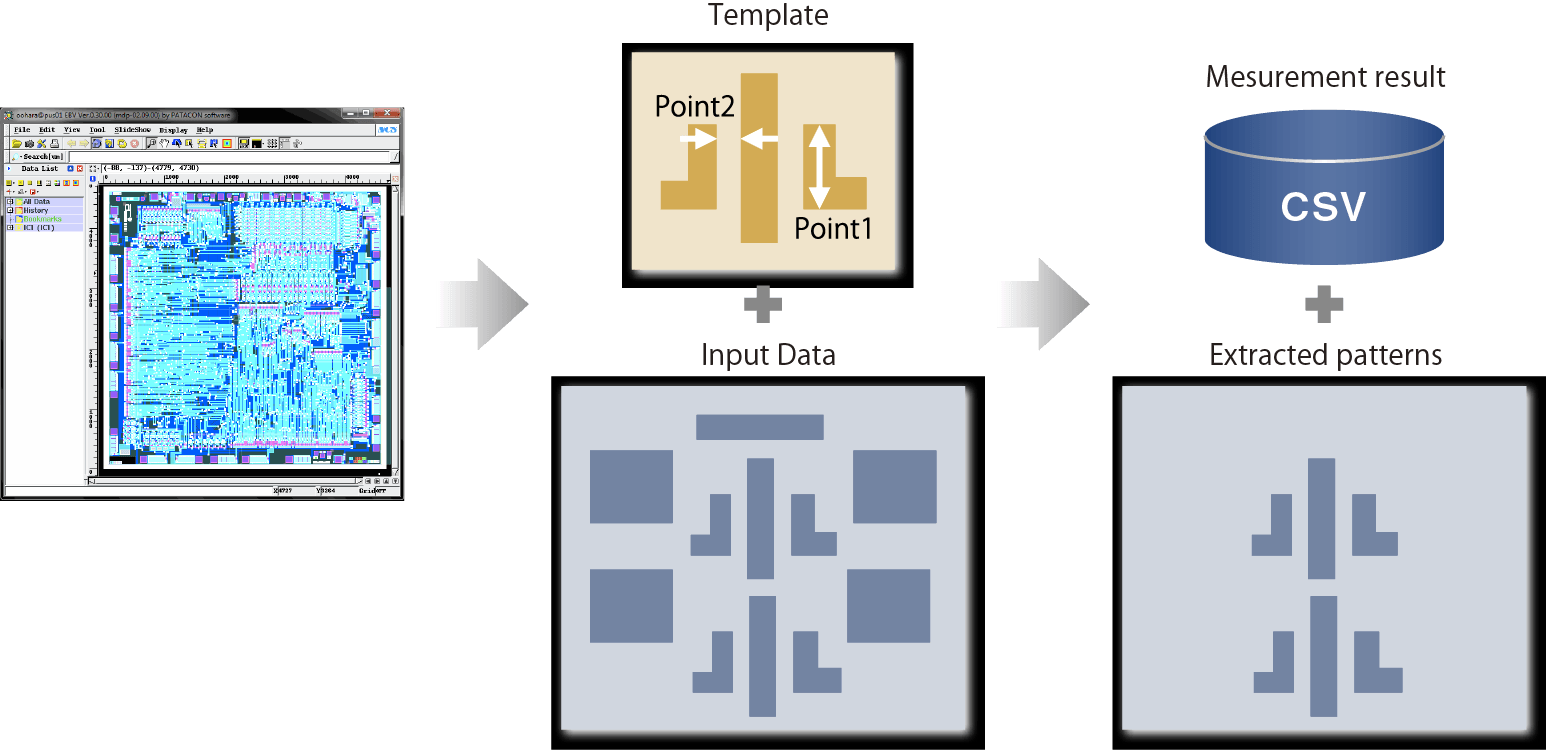
Pattern-Match function
- Template creation
- Perfect matching
- Transformation aware - mirror, rotate, scale
- OPC aware
- Measurement
- CSV output
- and more.
SCRD
SCRD is an application which reduces the number of shots on mask writing. It is gathering attention as a data optimization prior to fracturing because the pattern size is getting smaller and the mask writing time is getting increased. SCRD has two applications. One is SCRD-R for rectilinear patterns which a conventional OPC is applied. Another is SCRD-C for curvilinear patterns which ILT is applied.
SCRD-R
SCRD-R reduces the number of shots by removing jog, notch, and bump by considering the shot size and the change of contour due to mask writing.
SCRD-C
SCRD-C places rectangles base on the curved line of ILT. The placement of rectangles is done by rule basis. It can drastically reduce the number of shots compared to a rectangle placement by conventional fracturing.
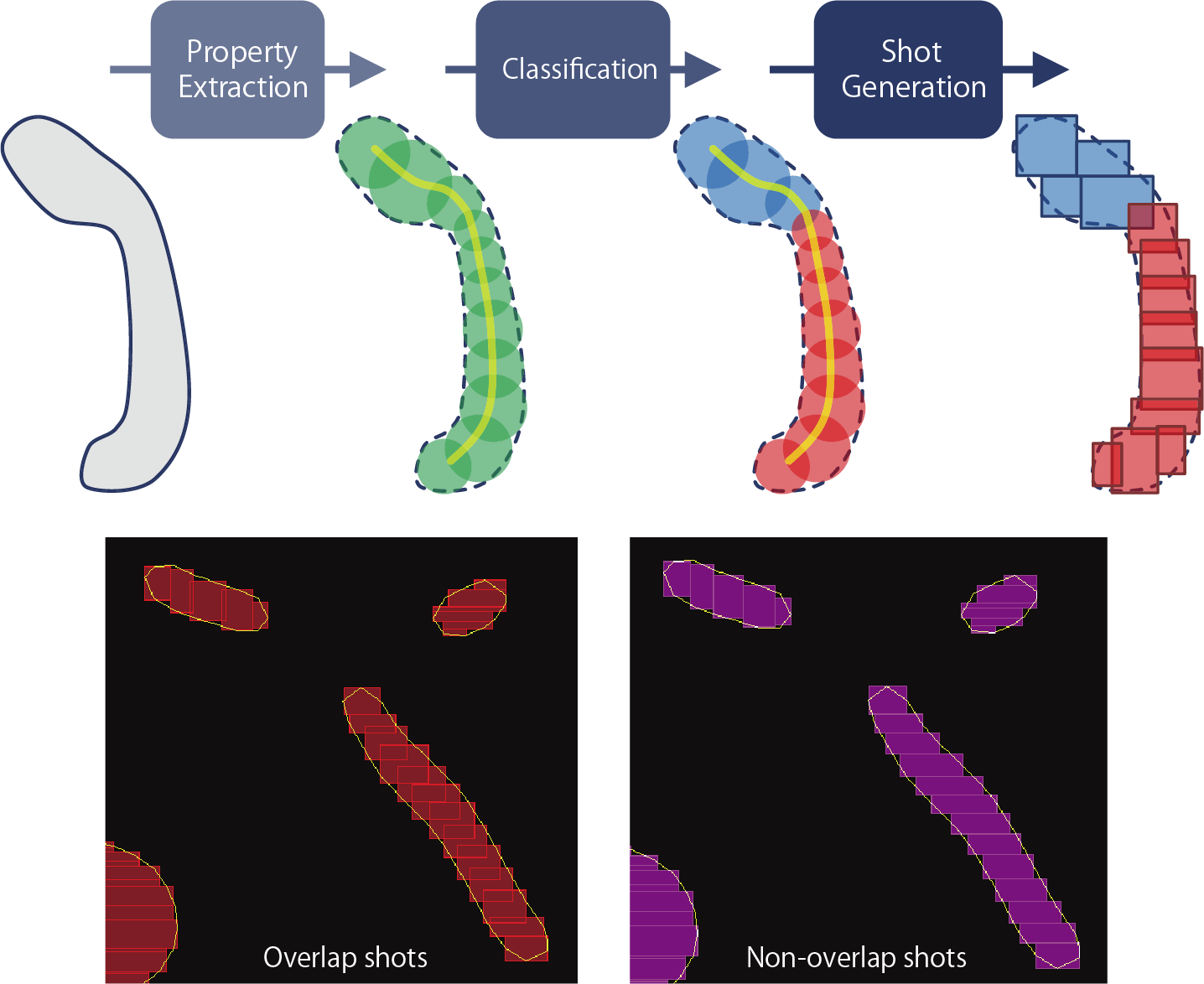
MPC
MPC stands for Mask Process Correction, and it mainly corrects micro loading effect of etching and forward scattering proximity effect of electron beam by a model basis. The mask process correction is gathering attention because the pattern size is getting smaller and because of EUV mask. MPC corrects those effects by biasing.
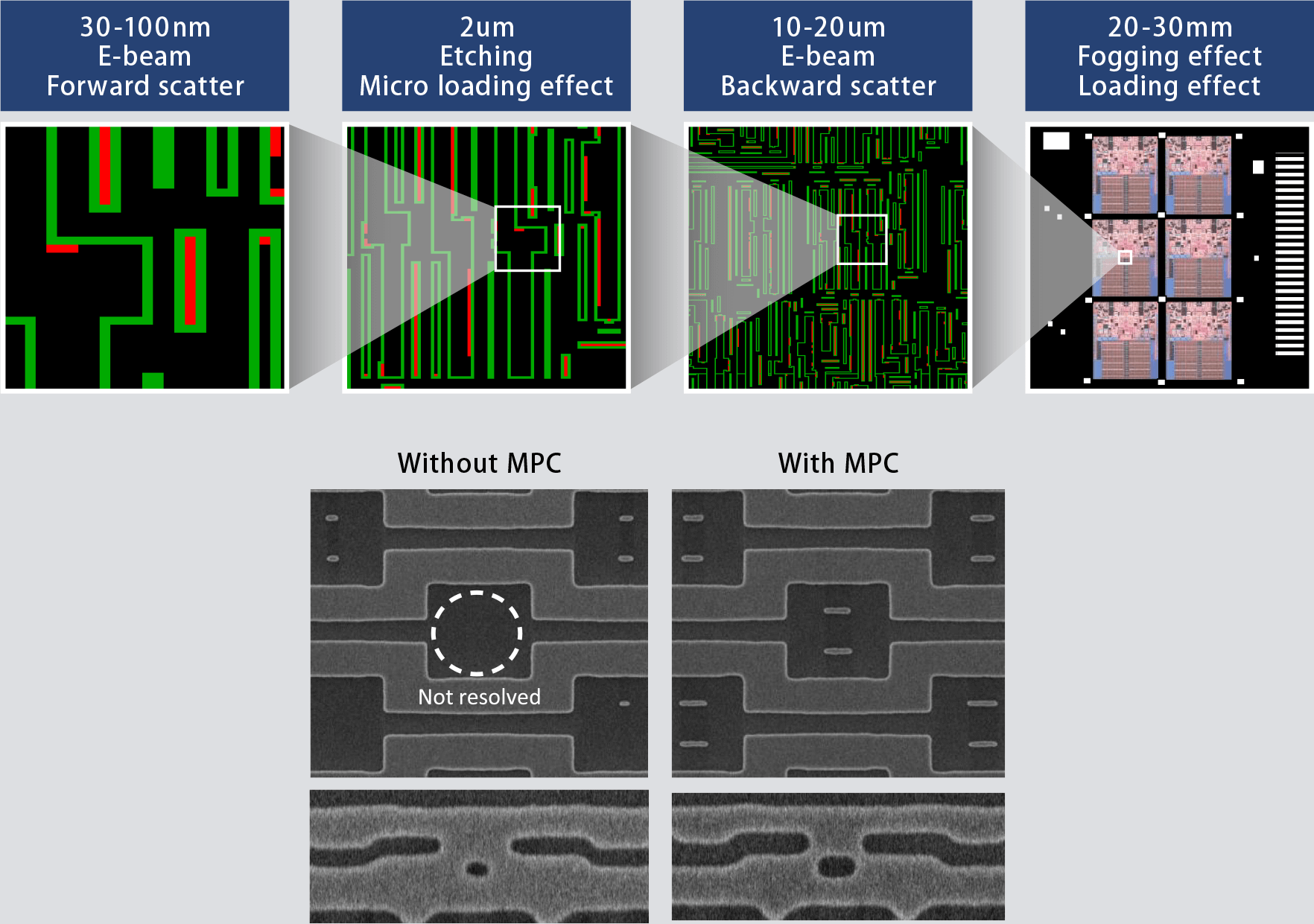
MPC function
- Model calibration
- Feed forwarding
- Process delay adjustment
- MPC (Correction process)
- MPC to assist features only
- Process emulation
- Topology check
- and more.
MFM
MFM, short for Mask Fingerprint Mapping, is a modelling tool used to predict global loading effects caused by lithography, development, and etching. It creates a model to predict global CD error map. Requirements for mask global CD uniformity are getting tighter recently because the CD is getting narrower. This makes the global CD error correction more significant. The global CD error map created by MFM can be used to correct global CD errors on incoming layouts never written before.
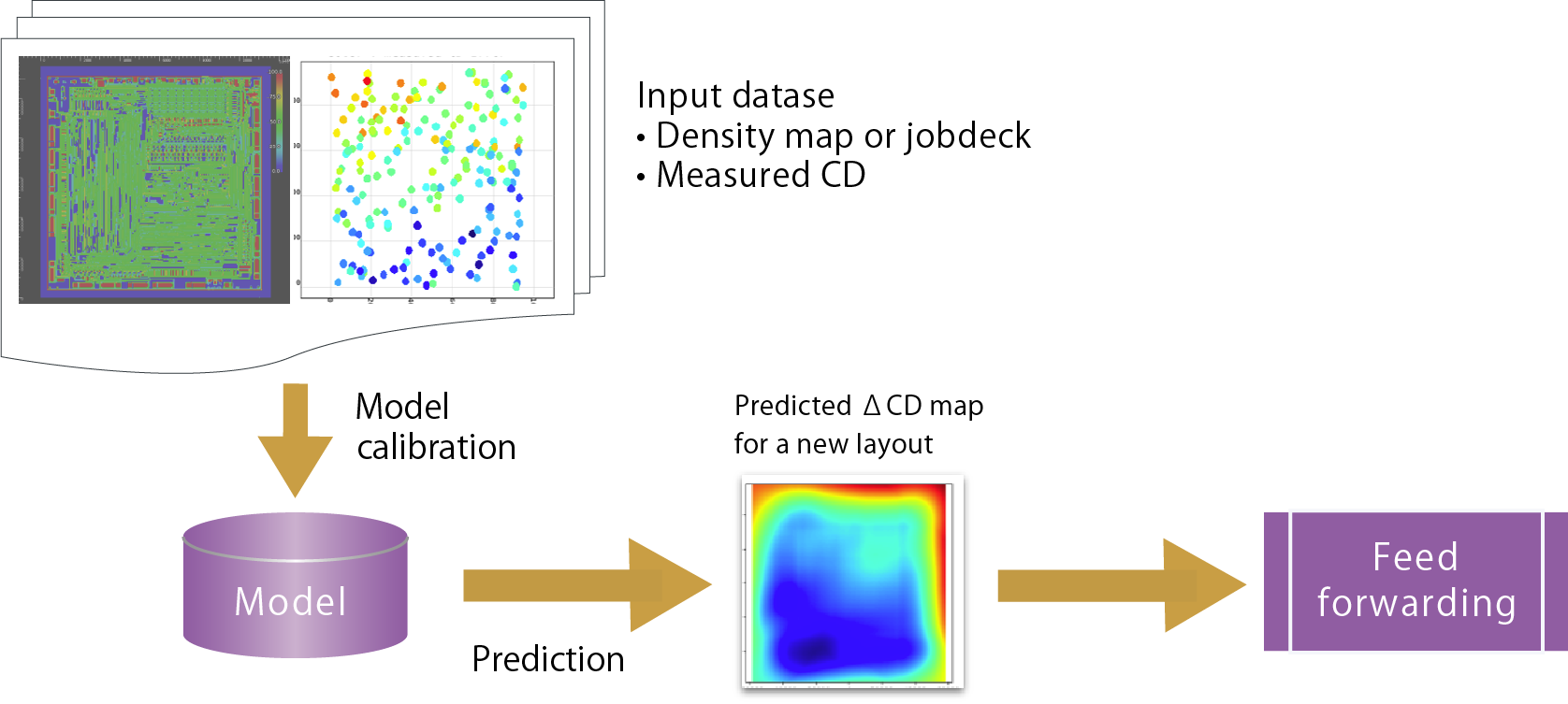
Global CD Error Model
MFM
- Model calibration
- Feed forwarding
- Outlier detection
- Density map creation
- Model update function
- Report generation
- and more.
EBV
EBV is a data viewer which can display various data format including jobdecks. It has features such as fast, precise, direct display without intermediate files, unlimited open files, and more. It can also do various operations such as measurement and density calculation to the data displayed. Moreover, it supports a recipe generation for CD-SEM and registration tools.
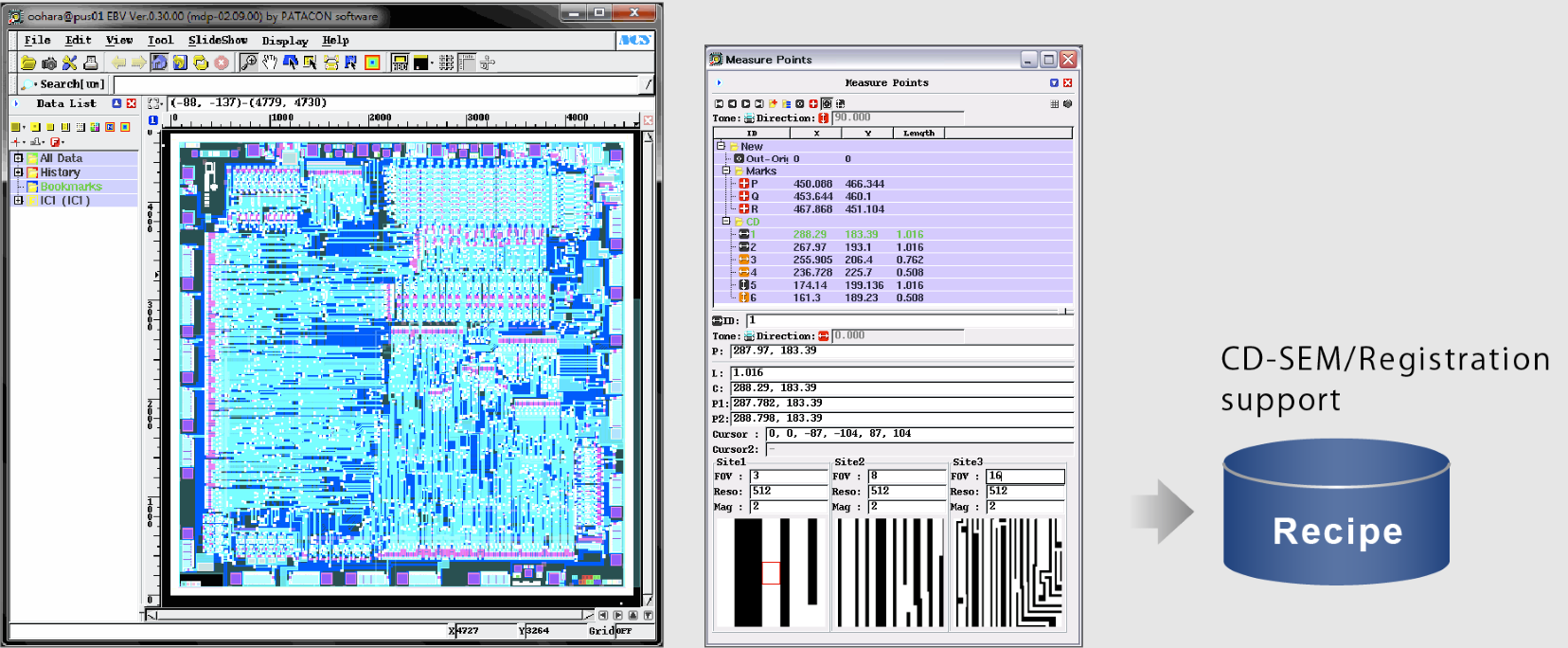
EBV function
- Various data display
- Cache file
- Chip / cell line display
- Cell coloring
- Highlighting
- Hatching
- Transformation - mirror, rotate, scale, etc.
- Data header / figure count display
- Cell tree display
- Density, density map calculation
- Figure information display
- Cell display
- Measurement
- and more.
EBV Chip
CAD Data
- GDSII
- GERBER
EB Data
- MEBES
- JEOL52 (v1, v1.1, v2.1, v3, v3.1)
- HL(700, 800, 900, 7000)
- VSB (11, 12)
- BEF
- MIC
SEMI
- P39 (OASIS)
- P44 (OASIS.VSB/MASK)
Inspection Data
- LM7000
- DM (NPI-5000)
EBV Jobdeck
EB Data
- MEBES (JB)
- MEBES Extend (eJB)
- JEOL (JDK)
- JEOL Express (JDF)
- VSB11 (MDS)
- VSB12 (MDS2)
- MIC (MS)
- HL (Lot)
- HL700 (JTX)
SEMI
- SEMI-P45 (Maly)
- SEMI-P10 (Text)
EBV Metrology Support (optional)
- Vistec LWM90xx
- Holon EMU
- KLA iPRO
- Zeiss PROVE